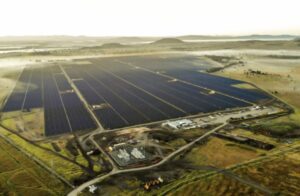Australia’s installed capacity of solar is expected to double to 18GW in the next two years as a wave of new large scale projects are completed and as households and businesses continue to turn to solar to reduce their electricity bills.
Industry statistician Sunwiz says Australia is recording record installations in both rooftop solar and large scale installations in 2018, with more 1.6GW installed until the end of September, nearly half from large scale solar. The annual total will be around 2.3GW to 2.4GW.
Green Energy Markets’s Ric Brazzale says he is expecting up to 4GW installed in 2018 alone, although that number depends on the speed of commissioning and could be lower if project completion is delayed.
“It’s a massive year for solar,” Sunwiz director Warwick Johnston says.
By the end of 2020, Sunwiz says, the current capacity of 9GW is expected to double to 18GW, with another 4GW of large scale solar, another 4GW of small rooftop solar, and another 1GW of large rooftop solar installations (over 100kW). (See graph below).
That would represent a doubling also in the share of renewables of delivered electricity from around 5 per cent to 10 per cent.

As we report elsewhere, another three big solar farms have joined the grid just in the past week – the largest solar installations in their respective states – South Australia (Bungala), Victoria (Bannerton) and NSW (Colleambally).
Johnston says the record year for rooftop solar, with commercial scale installations particularly buoyant as businesses, farmers and other look to their own installations. Danin Kahn of Todae Solar predicted that by 2030, 90 per cent of businesses would have solar on their rooftops.
The question for many is the future of policy, both in large scale and small scale.
The large scale renewable energy target (33,000GWh) will be met by 2020, ending the obligation of big retailers to contract or build a certain amount of renewables, and the only state-based initiatives coming from Victoria and Queensland, and the growing corporate market.

- Federal Labor intends to fill the policy vacuum with its 50 per cent renewable energy target, but its mechanism is still not clear – and it may take the form of reverse auctions, a RET extension or even accelerated closures of coal fired power generators. In NSW, many coal generators are due to close over the next 15 years.
- There is also a cloud over the small scale sector, given the recommendation by ACCC chair Rod Sims to abolish the SREA – the upfront rebate scheme – by 2021. It is not clear if the Coalition government will follow its advice.
Johnston says any such move before the election would be “political suicide” – particularly given the huge uptake in small business and farmers – but there is a risk of changes afterwards.
“It hasn’t been taken off the table since the ACC report, i think we’ve seen that the current government is happy to commit political suicide repeatedly. I don’t know that it (the SRES) is safe.”
Brazzale says there is a risk that the $40 clearing house price could be reduce, and that has already affected the market price on this. “There is a risk that the government will do something,” Brazzale noted.. But he noted that the ACCC review did not consider any of the benefits of solar. “We don’t know what they will to.”
Johnston says there is a question to ask if a 40 percent subsidy is the right level, “so may be there is a need to talk about the policy.”
Johnston says constructive options – rather than simply abolishing it – could include refining the subsidy, so there is less incentive for PV-only installations and greater support for PV that is accompanied by battery storage.
- He notes that in markets such as Germany and Australia, sales people aren’t even putting a PV-only option in front of their customers.
- A further incentive for storage will be the growing impact of rooftop and large scale on wholesale prices in the middle of the day, with prices already going negative in states such as Queensland, Western Australia and South Australia. That will make time-shifting output of solar more and more attractive.
- Around 70 per cent of German households are now installing storage with new PV arrays, compared to around 10-12 per cent in Australia. “I think the conversation will change at some point to what kind of battery do you want with that.”
Note: Further data and analysis of large scale solar plants – completed, under construction, planned and mooted – can be found in the Large scale lookout publication.







